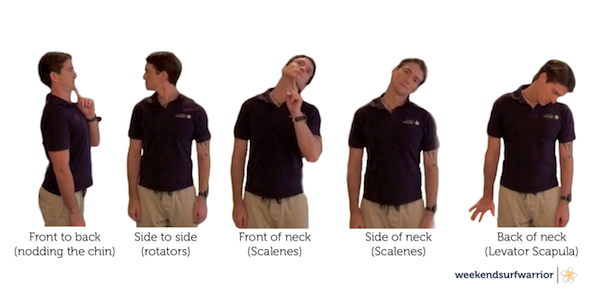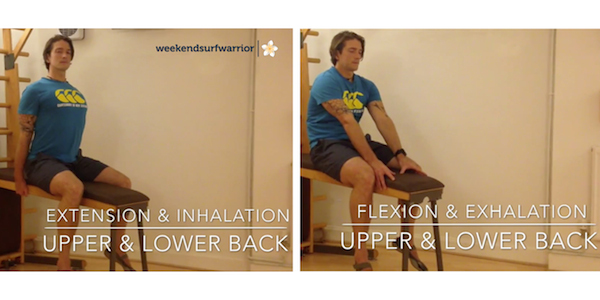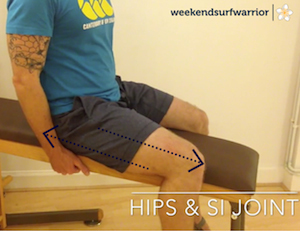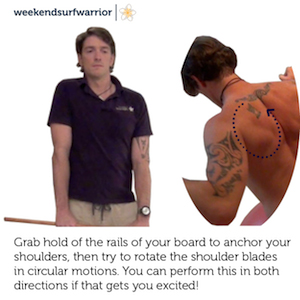This topic stems from a question that showed up in my inbox ages ago, and I’d like to readdress it because it’s applicable to more than just the inquirer.
The person in question wanted some ideas of how to keep his joints warm, lubricated and ready for action because:
- they forgot to warm up before paddling out;
- they did warm up, but since they got out the back, nothing happened and it’s a long wait between sets;
- they are freezing;
- their flexibility just ain’t what it used to be;
- their hip feels sticky after that last wipeout;
- it’s winter;
- they are bored; OR
- by the time they got to the end of this list, they got cold again!
These are the basics of keeping your body and joints ready for the next wave:
The bad news.
When your body starts to get cold, its natural reaction is to prioritize blood flow away from the extremities – arms and legs – and towards your core to protect the vital organs. As you can imagine pretty easily, this sucks if you want your muscles firing without some basic maintenance.
When was the last time you saw an olympic 100m sprinter, or 50m swimmer try to kick into full throttle without warming up? In fact, when was the last time you saw any professional athlete (and I don’t count curling or darts here) try to perform without warming up? It never happens.
The good news.
This process is reversible within reason so don’t try taking off your wetsuit in frigid temperatures and doing this. By the time you have started to shiver, and especially if you are prone to getting injured, it may already be too late. You may need to get out and fully warm up again before paddling back out. Try these exercises first, though.
We can use the same principles for warming up your joints that I talked about before*, but let’s apply them to when you are sitting on your board.
*If you would like to know more about this, check out my free warm up download here.
You have to keep moving! Sometimes just laying back on your board and paddling around can get you some of the way there.
Start with the basics, keep it simple, do it often.
If you perform this frequently enough, 3-5 repetitions in each direction can often be plenty. Ten is loads.
As with any mobilization, it is important to only move within a pain-free, comfortable range of motion. You will find that, with each attempt, your body will actually allow you to do more as the muscles become more relaxed.
Neck rotations (not shown on the video).
Create gentle movements forwards and backwards, side to side, and in rotation. When you think of the amount of shoulder injuries that have a neck correlation, you would think that you would see much more of this.

Shoulder rotations.
This is probably the most common thing I see done by other surfers between sets – rolling or flicking the shoulders. This is great stuff, but I wanted to show you something you might not already be doing for your rotator cuff, so you can compare and gauge what works better for you.
Upper and lower spine mobilizations.
You can always try get a yoga-style “Cat Stretch” going, but I would think twice about doing this on your board. It’s going to be tough unless you’re packing a SUP, and you might look kinda knob-ish. Here is a modified cat stretch for surfers.

Get this done at a breathing pace, grabbing the rails behind you and lifting the chest as you inhale. Then grab the nose of your board, push your shoulders back and tuck your butt under as you exhale.
If you have issues with lumbar discs, then simply laying on your board and extending to your forearms intermittently can make all the difference.
Hip/pelvis mobilizations.

Grab hold of your rails for balance, then slide your right knee forward as far as it will comfortably go without forcing it, then pull the knee backwards from the hip. Perform this exercise on both legs.
This is also a really useful exercise for after a heavy wipeout, or anytime your hip starts to tighten up in the water. You can teach your hip how to behave without having to paddle back in, so give it a try.
Also, if you are office bound during the week and have issues with your lumbo-pelvic-hip region, this little cracker could change your world.
It also might not. If not, send me an email and let me know!
If you have questions that need answers, send them to me at ash@weekendsurfwarrior.com. If you would just like some more information about any of my surf fitness programs, then please go to my website, www.weekendsurfwarrior.com.
Till next time guys. Hooroo!
-Ash Boddy


